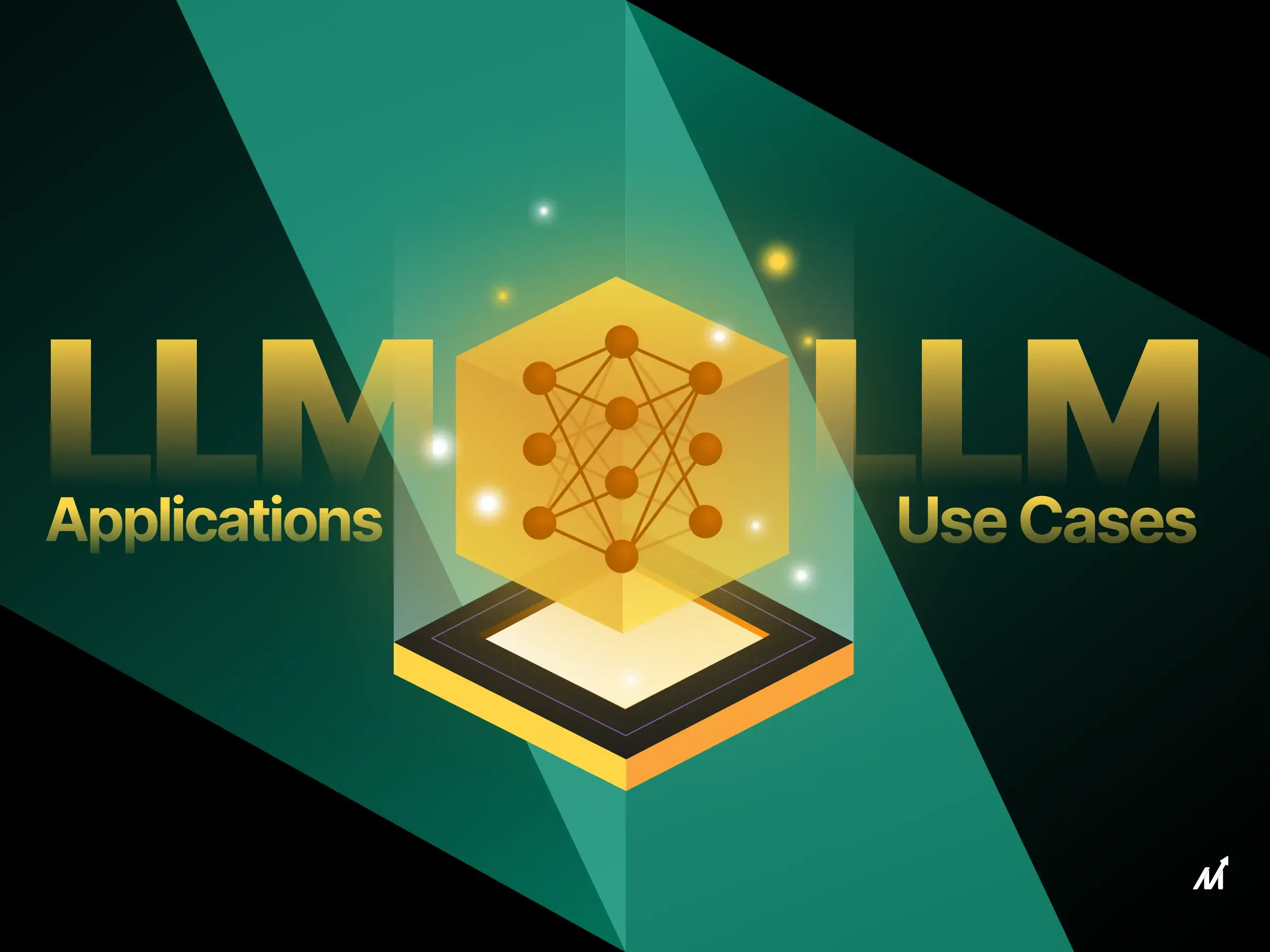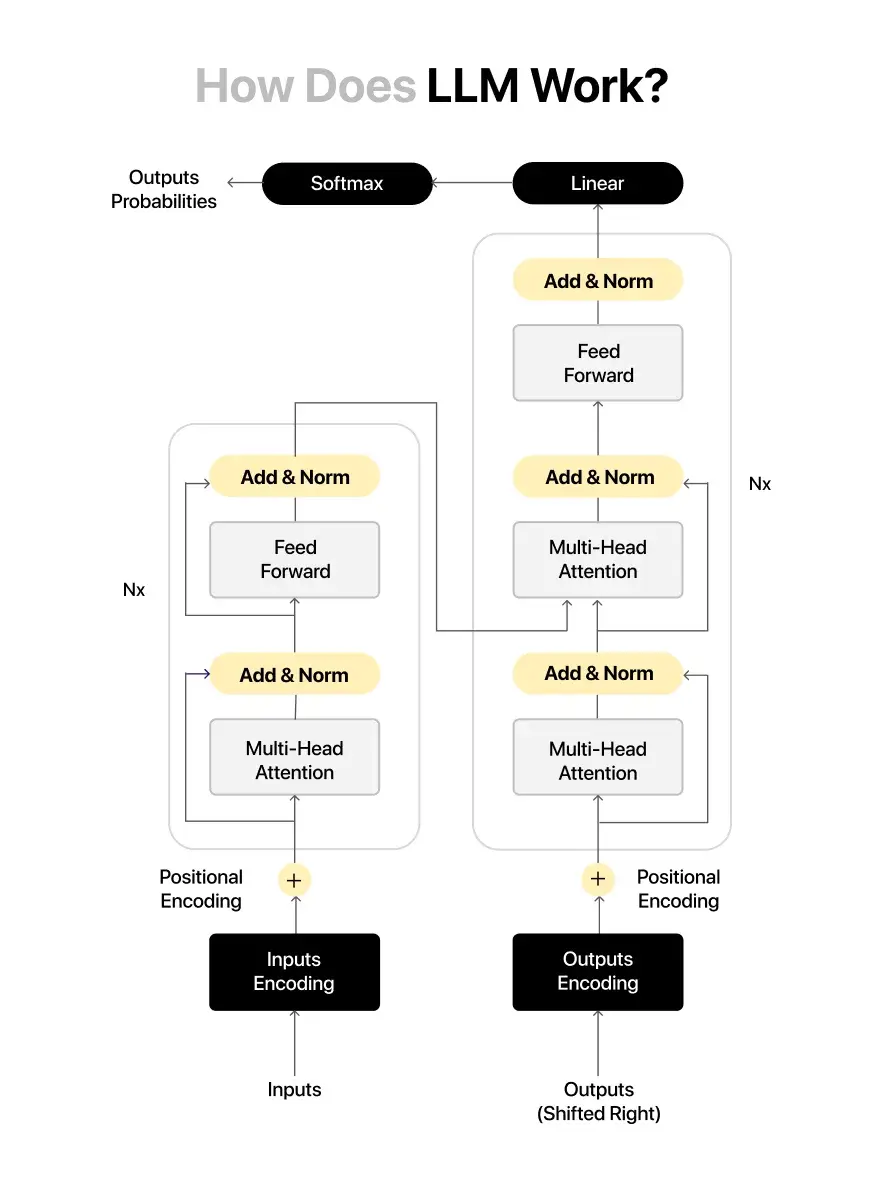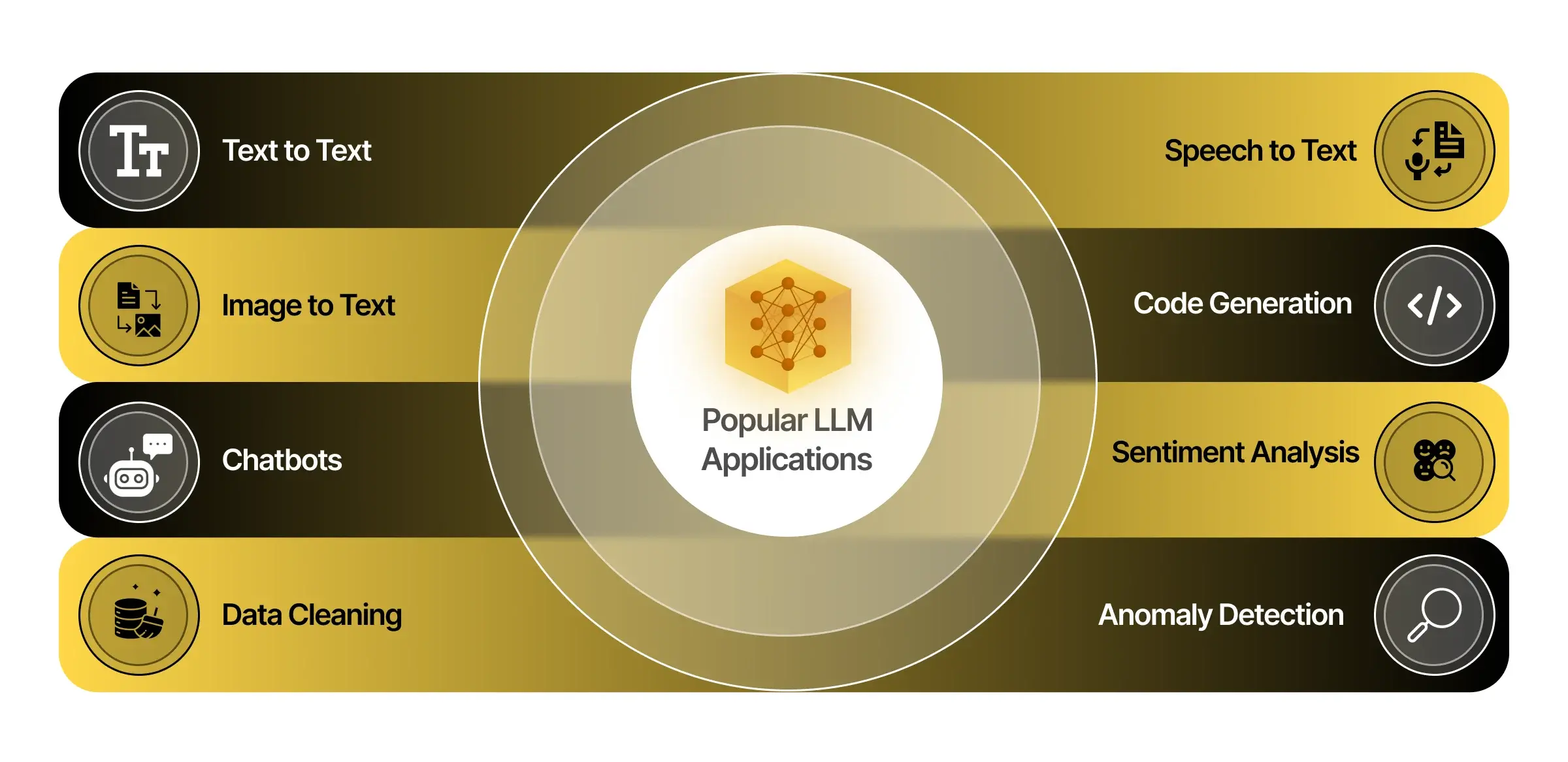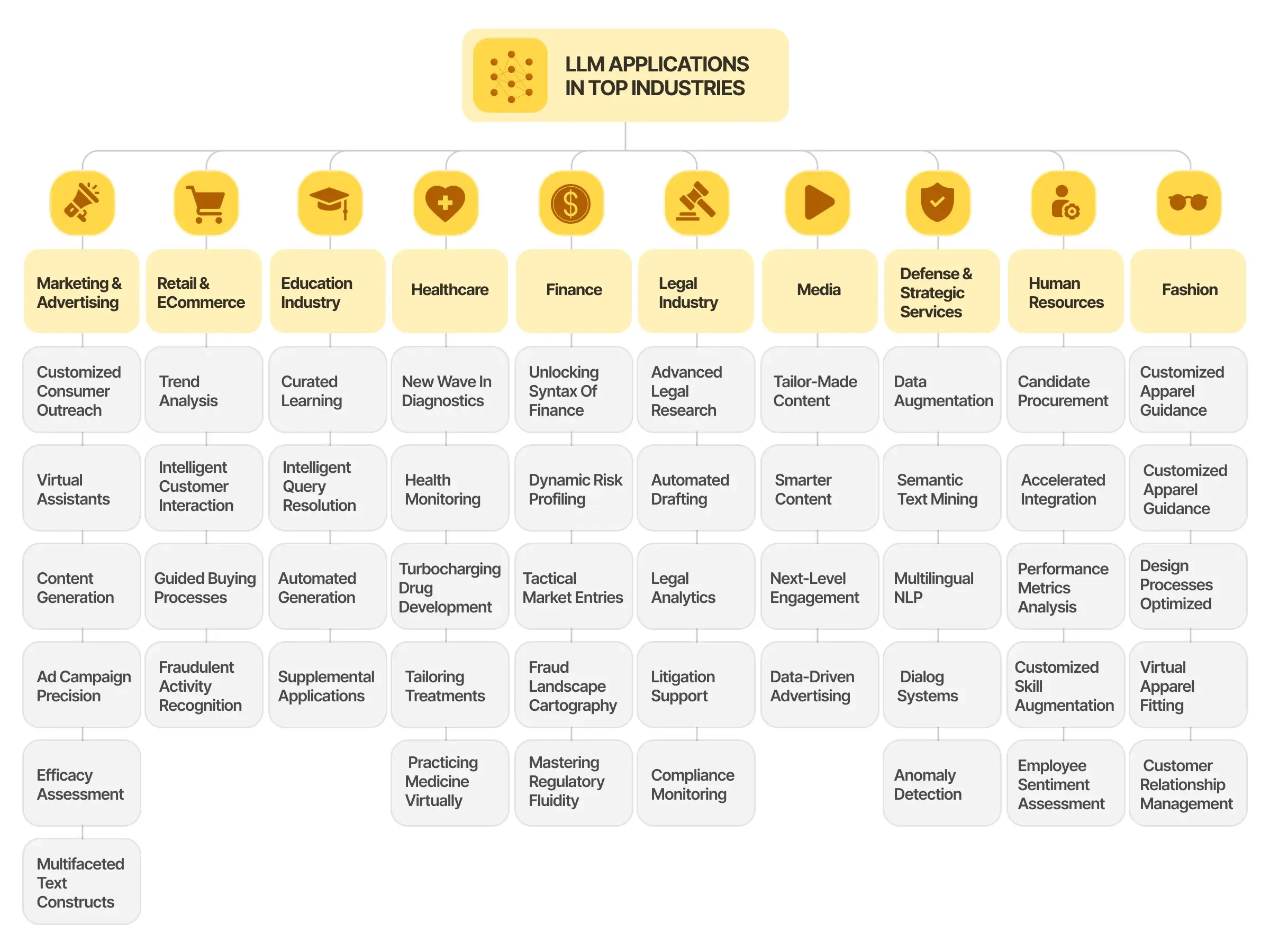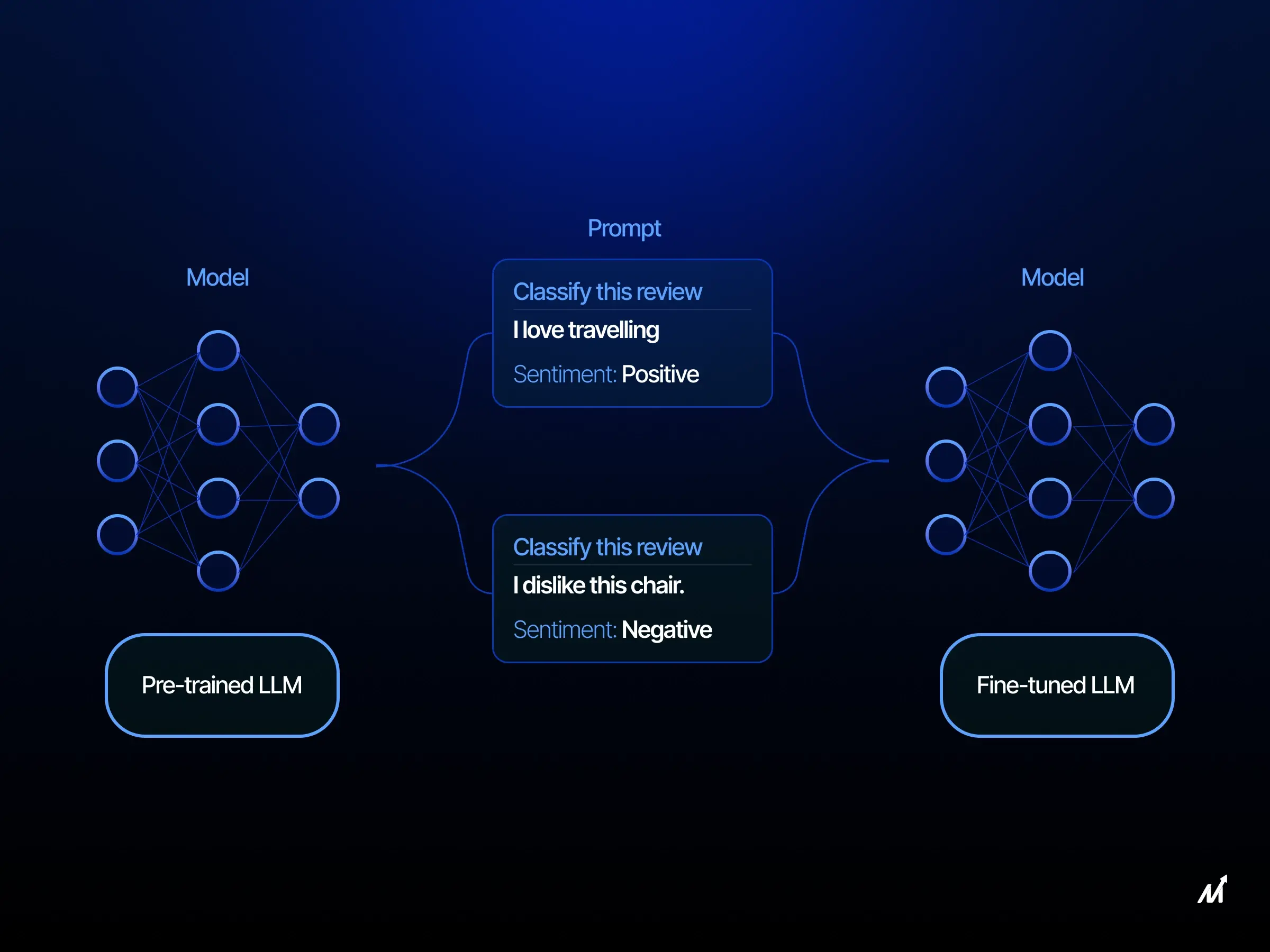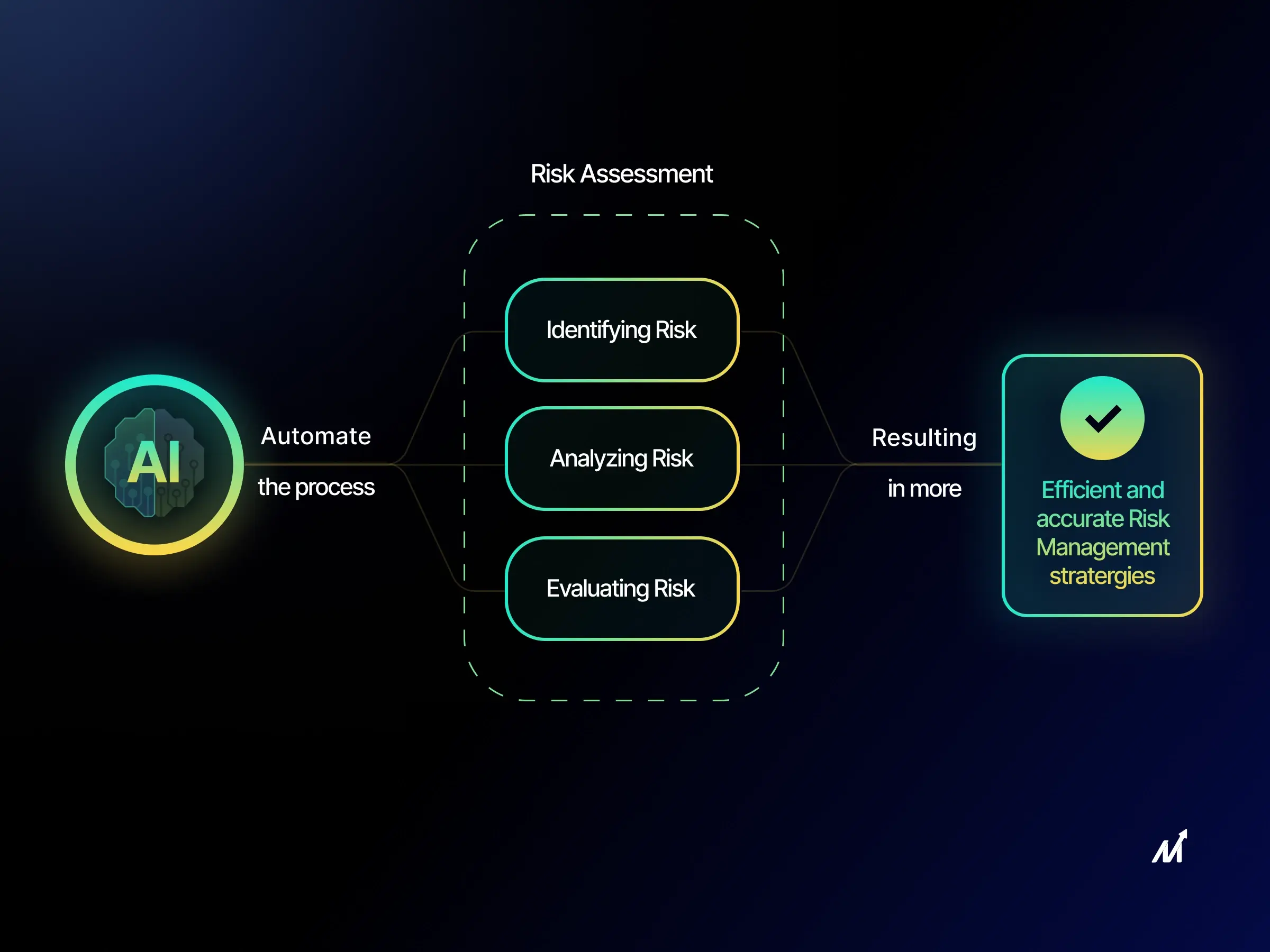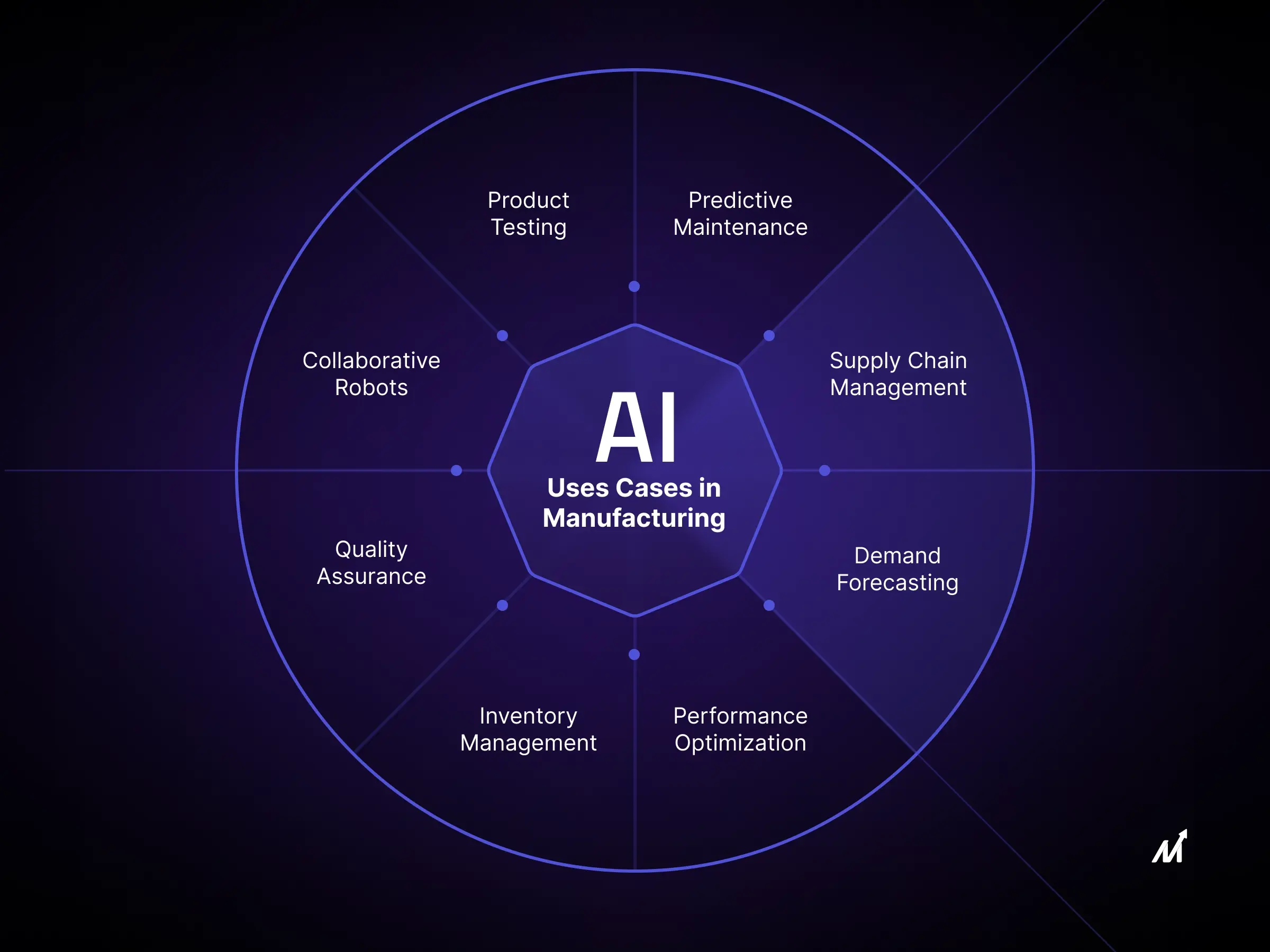The landscape of Natural Language Processing (NLP) has shifted dramatically with the introduction of large language model (LLM) like OpenAI’s GPT series and Google’s Transformer-based models. These LLM applications aren’t just incremental improvements but paradigm shifts in how machines interpret and generate human language.
These LLMs are mathematical giants constructed around advanced neural network architectures, sporting billions of parameters. Their strength isn’t just about raw computation; it’s in the finesse with which they navigate linguistic nuances. When an LLM scans text, it traverses an elaborate, multi-dimensional mathematical space to encode or decode meaningful information. It’s akin to mapping human language onto a complex geometric framework.
Now, what’s the real-world impact of LLMs? Far beyond simple text generation, LLMs are deployed in applications that were once considered beyond the reach of automated systems. Take machine translation—these models can now handle idiomatic phrases, local slang, and cultural nuances with startling accuracy. In sentiment analysis, they can differentiate subtle emotional undertones, offering businesses invaluable insights into customer opinions.
Where do we go from here? The next discussion point is to understand these LLMs in the context of operational architecture, their spectrum of applications, and future development. It’s more than just code and algorithms; it’s about redefining the boundaries of machine capabilities and human interaction.
The Core of LLMs
Let’s dissect the term “LLM”
Magnitude: LLMs are constructed with enormous computational parameters. Take GPT-3 as an example; it encompasses over 175 billion machine learning parameters and is refined on approximately 45 terabytes of textual information, which grants its wide-ranging applicability.
Linguistic Orientation: The primary function revolves around processing human-generated language.
Pattern Recognizer: These are designed to discern correlations or extrapolate within data sets.
LLMs attain proficiency in linguistic interpretation by capitalizing on many state-of-the-art methodologies that have emerged from contemporary machine learning research. Notable mechanisms include:
Transformative Algorithms – Deep learning models engineered for processing sequential data through self-attention. This allows the model to consider the full scope of the contextual elements in a given textual excerpt while calibrating its parameters.
Bi-Directional Encoding: Originating from the foundational BERT studies, this mechanism utilizes transformers to scrutinize linguistic elements preceding and succeeding a specific term, thereby rendering a more comprehensive understanding of contextually ambiguous phrases.
Auto-Regressive Frameworks: Models employing this approach leverage antecedent textual elements to prognosticate subsequent ones, often utilized in systems that generate new textual content. This method proves particularly useful in maintaining coherence and context-awareness.
Why is LLM so Important for Businesses?
Large language model is the engine behind the scenes, making many of our modern tech applications smart and responsive. Imagine a colossal neural network, often based on Transformer architecture, acting as a giant sponge soaking up vast amounts of text data. The model digests this ocean of words and starts understanding the building blocks of language, such as syntax, semantics, and context.
Training LLMs is like putting them through an exhaustive boot camp. You keep throwing sentence after sentence at them, and their task is to predict the next word in the sequence. If they get it wrong, their internal math—a complex arrangement of billions of parameters—tweaks itself. The model says, “Okay, I messed that one up. Let me adjust so I do better next time.”
The exciting part is what happens after the training. You can then specialize this well-trained model to do specific jobs. Need it to summarize lengthy medical journals? Easy. Do you want it to turn spoken language into written text? Done. The applications are broad, from your everyday virtual assistants to automating complex workflows in industries.
The fascinating bit is that they keep getting better. With every iteration and fine tuning, these models become more proficient, capable, and versatile, pushing the boundaries of what machines can understand and accomplish.
The LLM Design and LLM Architecture: The Overview
What is Architecture in the Context of LLMs?
The term “architecture” in the context of Large Language Models refers to the structural foundation upon which the entire model is built. If you’re familiar with architectural blueprints for buildings, think of this as the blueprint for the model’s neural network. In simple terms, it dictates how the basic building blocks—known as neurons—are organized and connected. The architecture sets the rules for how information flows through the model, how it’s processed, and how final outputs are generated.
Core Components
- Layers: These are the workhorses of any neural network. In LLMs, layers are typically organized into three main types: the encoder, the decoder, and often an attention mechanism that enables the model to focus on specific parts of the input data.
- Neurons: Each layer consists of a set of neurons, which are tiny computational units that perform simple mathematical operations.
- Activation Functions: These are equations that determine the output of a neuron. They add non-linearity to the system, allowing the model to learn from the error and make adjustments.
- Transformer Architecture: Modern LLMs generally use a specific type of architecture known as the transformer. The Transformer architecture serves as a backbone for advanced language models. It’s split into two parts: an encoder to break down the input into tokens, and a decoder to interpret these tokens. The key feature is self-attention, which allows the model to look at multiple parts of the input at once. This makes it more efficient and accurate compared to older methods like LSTM, enabling it to understand context and make better predictions.
What Makes Architecture Sophisticated?
The sophistication in architecture arises from a few key elements:
- Depth: The number of layers in the neural network. More layers allow the model to understand and generate complex language structures but can be computationally expensive.
- Width: The number of neurons in each layer. A greater number of neurons can increase the model’s capacity to learn but also require more computational resources.
- Parameter Tuning: Specific aspects like learning rate, batch size, etc., can be fine-tuned to optimize performance.
What is Design in LLMs?
While architecture is about ‘what’ the model is, design is about ‘how’ to best utilize that model. It includes makes LLM models operational, efficient, and user-friendly.
Core Elements of LLM Design
- Hyperparameters: These are variables that govern the learning process but are not learned from the data. Examples include the learning rate, batch size, and number of epochs. The proper tuning of hyperparameters can substantially improve the model’s performance.
- Data Pipelines: This is about how you feed data into the model. The design establishes efficient pipelines to clean, preprocess, and feed data in a way that maximizes computational efficiency and model accuracy.
- Resource Allocation: This is the strategic use of hardware resources. Whether it’s maximizing GPU usage or distributing tasks across multiple servers, efficient resource allocation is key for scalable and fast processing.
Overall, architecture provides the intellectual prowess of LLMs—their ability to understand and generate coherent and contextually appropriate language. Design, on the other hand, ensures this power is harnessed in the most effective and user-friendly manner, making the model scalable and efficient.
How Does LLM Work?
In the world of Large Language Models (LLMs), a multi-step method is used to make them as effective as possible. Initially, these models need to ‘learn’ from a big collection of data, often as large as petabytes. This first step is called unsupervised learning, where the model tries to make sense of data that doesn’t have labels or structure. This is helpful because there’s a lot more of this type of data available, and the model starts to understand how different words and ideas relate to each other.
After that, the model goes through a phase known as semi-supervised learning. In this step, some of the data has labels or tags that help the model become more accurate in understanding different ideas and words.
The next big step involves using a special type of neural network known as a transformer. The neural network helps the model understand the relationships between different words and ideas even better. It uses something called a self-attention mechanism, which helps the model decide how important each word or ‘token’ is in understanding a sentence or paragraph.
Once the LLM is fully trained through these steps, it’s ready for practical use. By asking it questions or giving it prompts, the model can generate text, summarize articles, analyze feelings in text, or even answer questions. This makes it useful for a variety of real-world tasks.
The Most Popular LLM Applications
1. Text to Text: Summarization, Translation, Question Answering
Text-to-Text LLM applications generally fall under the umbrella of Natural Language Processing (NLP), employing sophisticated algorithms such as Transformer models or BERT (Bidirectional Encoder Representations from Transformers). In the context of text summarization, techniques like Rouge Score or BLEU (Bilingual Evaluation Understudy) metrics evaluate the quality of generated summaries. For businesses, this can be invaluable for auto-summarizing lengthy reports, enabling quicker decision-making. Text translation services often employ LLMs trained on parallel corpora and use metrics like METEOR for evaluation. These services are crucial for businesses operating globally, enabling seamless communication across language barriers. Question-answering platforms often rely on contextually-aware algorithms to provide highly accurate answers. Businesses can integrate LLMs into support systems for real-time, data-backed responses.
2. Speech to Text: Transcription Services, Voice-Activated Assistants
The crux of speech-to-text LLM applications lies in Automatic Speech Recognition (ASR) systems. The ASR systems employ Hidden Markov Models or Deep Neural Networks to transcribe spoken words. Businesses can leverage ASR systems for automated real-time transcription services during conference calls, creating easily searchable and archivable text records. Voice-activated assistants employ ASR along with NLP to execute commands. The commercial application here ranges from facilitating hands-free operations in warehouses to sophisticated customer interaction systems in retail.
3. Image to Text: Image Captioning, OCR (Optical Character Recognition)
Image-to-text LLM applications employ a combination of Convolutional Neural Networks (CNNs) for feature extraction and Recurrent Neural Networks (RNNs) or Transformers for generating corresponding text. OCR technology specifically employs image pre-processing techniques like binarization and machine learning classifiers like k-NN or SVM to extract text from images accurately. For businesses, LLMs can translate to auto-tagging of visual content for SEO, automated sorting of invoices, and more.
4. Code Generation: Auto-generating Code Snippets, Bug Fixing
Sophisticated LLM applications trained on coding databases can predict likely code snippets, thereby accelerating software development cycles. LLMs often employ abstract syntax trees or control-flow graphs for greater accuracy. In bug fixing, static code analysis tools are integrated to identify vulnerabilities, and machine learning models suggest appropriate fixes. This enhances the efficiency and robustness of business applications.
5. Chatbots: Customer Support, Interactive FAQs
Chatbots in business settings are commonly built using decision trees, stateful LSTM networks, or even more advanced architectures like GPT (Generative Pre-trained Transformer). These LLM applications are often trained on a business’s historical customer service interactions, which enables them to solve issues more contextually. Besides customer support, they can perform roles ranging from lead generation to automated upselling, significantly reducing manpower costs.
6. Sentiment Analysis: Determining Customer Sentiment from Reviews or Social Media
Sentiment analysis often employs Natural Language Understanding (NLU), a subfield of NLP, to identify nuances in language that indicate sentiment. TextBlob, VADER (Valence Aware Dictionary and sEntiment Reasoner), and more advanced neural network models are commonly used. Businesses can integrate LLM applications into CRM systems, allowing for real-time customer sentiment tracking and more targeted customer interactions.
7. Data Cleaning: Identifying and Rectifying Erroneous Data Entries
Data cleaning processes often employ unsupervised learning algorithms like k-means clustering or hierarchical clustering to identify erroneous or anomalous data points. Additionally, decision trees or rule-based systems can be configured to identify inconsistencies in structured data. For businesses, LLM applications in data cleaning ensures the reliability of analytics, which is crucial for strategy planning and operational efficiency.
8. Anomaly Detection: Identifying Outliers or Anomalies in Datasets
For anomaly detection, statistical techniques like Z-score or machine learning algorithms like Isolation Forests are commonly used. Time-series data might employ Long Short-Term Memory networks (LSTMs) for detecting anomalies over time. Businesses can use anomaly detection in various domains such as fraud detection, quality control in manufacturing, or market trend prediction, thereby preemptively identifying and mitigating risks.
By understanding the technical underpinnings and business applications of these various LLM functionalities, businesses can make more informed decisions on how to integrate LLMs into their operations for maximum impact. Additionally, businesses can calculate LLM API pricing to compare different LLMs before selecting one for the project.
LLM Applications in Top Industries
Let’s understand the impact of Large Language Models (LLMs) on various sectors.
1. LLM Application in Marketing and Advertising
LLM applications are not merely text generators. LLMs are intricate systems leveraging state-of-the-art machine learning architectures to reshape sectors like marketing, customer service, content production, and data analytics. Below, we unpack ten salient applications of LLMs in marketing and advertising:
1.1 Customized Consumer Outreach
LLMs can craft custom marketing collaterals, from email bulletins to tailored social media messages. Moreover, LLM’s algorithms can examine consumer behavior—such as cart abandonment—to formulate emails that resonate with specific consumer interests, offering product suggestions and time-sensitive promotions.
1.2 Virtual Assistants
LLMs empower companies to develop chatbots with almost human-like conversational abilities, making round-the-clock customer service attainable without scaling the human workforce. For instance, an LLM can facilitate a chatbot that elucidates product features, troubleshoots issues, and provides shipping updates.
1.3 Content Generation
The prowess of LLMs extends to drafting value-driven content, be it blog entries, specialized articles, or digital marketing copy. Additionally, LLMs can automatically generate pieces that raise brand awareness and drive consumer engagement. A quintessential application could be an LLM generating articles around a novel product release or engendering a social media initiative to capture user testimonials.
(Read more about Generative AI applications)
1.4 Ad Campaign Precision
LLM algorithms can mine data to identify potential markets, allowing for ad placements that are laser-focused on consumer segments more likely to convert. An LLM could, for example, scrutinize user behavior to direct advertisements to individuals already exploring related products.
1.5 Efficacy Assessment
LLMs excel in evaluating the efficacy of existing marketing strategies by sifting through customer interactions and social media footprints. LLMs can process vast datasets to discern patterns or trends, thus supplying actionable insights for fortifying subsequent marketing initiatives.
1.6 Multifaceted Text Constructs
Beyond traditional marketing materials, LLMs possess the finesse to churn out an array of creative textual forms—be it code snippets, scripts for videos, compositions for musical numbers, or even unconventional correspondence methods like hyper-personalized letters. Consequently, the overarching aim is to captivate and engage the target audience through content diversification.
(Read more about ChatGPT integration)
2. LLM Application in Retail and eCommerce Ecosystems
In retail and electronic commerce, Large Language Models (LLMs) are revolutionizing traditional paradigms and establishing new norms for consumer experience and business operations. Moreover, utilizing high-dimensional vectors and neural network layers based on Transformer architecture, LLMs can sift through multiple data points, like consumer behaviors, transactional history, and online interactions, to extract actionable insights.
2.1 Trend Analysis and Hyper-Personalized Recommendations
By processing consumers’ historical transactional data, digital footprints, and social network interactions, LLMs discern underlying biases and behavioral patterns. Additionally, LLMs computational ability enables them to generate hyper-personalized suggestions for goods and services tailored to individual preferences, fiscal parameters, and situational needs. It’s not merely about clustering similar products but about predictive algorithms that align consumer aspirations with commercial opportunities.
2.2 Intelligent Customer Interaction
Human resources are limited, and their time is better spent addressing intricate issues necessitating nuanced understanding. Therefore, LLMs serve as front-line agents, dealing with frequently asked questions concerning commodities, offerings, and logistical matters. LLM’s capability to produce contextually accurate and timely responses alleviates the workload from customer service staff, enhancing operational efficiency.
2.3 Guided Buying Processes
Far from being a transactional facilitator, modern-day e-commerce is an experience that a consumer traverses from landing on a webpage to finalizing a purchase. Therefore, LLMs serve as a guide through this journey. LLM’s capacity to comprehend queries in natural language equips them to assist in product selection, simplifying navigational challenges, and even finalizing transactions. These models break down the digital barriers, making the platform easily accessible, thus accelerating the rate of conversion from a casual visitor to a committed customer.
2.4 Fraudulent Activity Recognition
E-commerce environments are not impervious to fraudulent activities jeopardizing revenue and reputation. Consequently, LLMs are sentinels trained to flag anomalies in transactional behavior or account activities. Through heuristic analysis that involves studying behavior over time, LLMs can raise immediate alerts for suspicious actions, like irregular bulk purchases or multiple failed payment attempts, facilitating prompt preventive measures.
3. LLM Applications in Education Industry
3.1 Curating Individualized Learning Trajectories
LLMs can construct custom-made educational roadmaps for pupils. Specifically, students grappling with intricate subjects such as advanced calculus could benefit from a computational algorithm that prescribes specialized exercises and analytical tasks. These Large Language Models can be finetuned to align with the student’s unique intellectual gaps, facilitating optimized learning outcomes.
3.2 Intelligent Query Resolution
LLMs bring into play the feature of semantically intricate yet naturally expressed solutions to scholastic queries. For instance, suppose a student endeavors to understand the geopolitical dynamics that led to the formation of the United States. A LLM is engineered to decode the multifaceted nature of the question and subsequently articulate a well-rounded, analytically rigorous response that does not merely touch upon historical facts but also delves into the sociopolitical context.
3.3 Automated Generation of Evaluative Instruments
One of the most revolutionary capabilities of LLMs lies in their aptitude to auto-generate scholastic assessments. Moreover, envision a student engrossed in preparations for a quantum physics examination; the LLM could dynamically compile a set of problems calibrated to the learner’s current comprehension level. This would reinforce previously acquired knowledge and flag areas demanding additional scrutiny.
3.4 Supplemental Applications
Automated Academic Evaluation: LLMs can function as auxiliary evaluative tools for educators, relieving them of the labor-intensive task of grading voluminous manuscripts or computational assignments. Consequently, this frees educators to prioritize pedagogical strategy development and other facets of academic instruction.
Virtualized Educational Ecosystems: The power of LLMs extends to establishing online pedagogical platforms accessible from any location. Thus, this flexibility allows learners to engage in educational activities on demand, mitigating constraints imposed by traditional brick-and-mortar settings.
Multilingual Material Conversion: The utility of LLMs transcends linguistic barriers, offering translation services for educational resources. Additionally, by dynamically converting educational texts into various languages, they democratize access to knowledge, enabling students to absorb information in their vocabulary.
4. LLM Applications in Healthcare
4.1 A New Wave in Diagnostics
The fascinating thing about Large Language Models (LLMs) in healthcare is that they’re not just data crunchers. Instead, LLM’s are pattern detectives. Large Language Models meticulously scan medical records and images to find unique markers of disease that might easily slip through human analysis. Thus, it’s like having a medical investigator who unearths clues from a mound of data to reach a highly informed diagnosis.
4.2 Health Monitoring, Upgraded
Beyond crunching numbers and stats, LLMs provide a sort of ongoing surveillance of a patient’s overall well-being. Continuous real-time tracking of key health metrics is no small feat, and here, LLMs stand as unsung heroes. Moreover, if these models detect something awry—a sudden spike in blood pressure or a plummeting glucose level—an alert is activated. It’s preventive care for the digital age.
4.3 Turbocharging Drug Development
Creating new medications can be a years-long, billion-dollar gamble. LLMs aren’t eliminating the complexity but are adding horsepower to the research phase. By scanning and synthesizing countless scientific papers, they can identify potential drug targets and efficacy factors much more quickly than traditional methods. It’s as if you’ve got a round-the-clock research analyst who can scan a library’s content in seconds.
4.4 Tailoring Treatments to Individuals
In today’s one-size-fits-all medicine, the personal touch often gets lost. LLMs are changing that narrative by providing highly customized treatment plans. Conversely, LLMs consider everything, from your medical history and genetic makeup to lifestyle choices. It’s about going beyond the standard checklist to provide healthcare that fits like a glove.
4.5 Practicing Medicine in a Virtual World
The educational aspect is also getting a refresh. LLMs can design realistic virtual environments where healthcare providers can refine their skills without risk. We’re not just talking about basic training modules but fully immersive scenarios that prepare medical staff for the unpredictable challenges of real-life healthcare.
5. LLM Applications in Finance
5.1 Unlocking the Syntax of Finance
Financial documents can be a labyrinthine web of figures, jargon, and syntactical complexity. Conversely, LLMs dissect this information layer by layer, enabling financial experts to zero in on trends, anomalies, and indicators that drive decision-making. It’s as if analysts suddenly gain an enhanced cognitive toolkit to decrypt market signals with precision and speed.
5.2 Dynamic Risk Profiling
Assessing financial risk isn’t solely about crunching numbers but understanding the underlying factors and variables. LLMs push the boundary by incorporating qualitative elements into their risk models. Consequently, with machine learning algorithms, these models dissect many information points ranging from a borrower’s transactional behaviors to industry-wide market fluctuations. This multi-dimensional risk landscape substantially elevates the quality of credit and investment decisions.
5.3 Tactical Market Entries
Algorithmic trading isn’t new, but the methodology is undergoing a renaissance, courtesy of LLMs. The LLMs can capture and synthesize real-time data streams ranging from trading volumes to geopolitical news. Subsequently, the insights are channeled into the trading algorithms to strategize market entries and exits. The result? A near-clairvoyant system optimized for profitability and resilience.
5.4 Fraud Landscape Cartography
Financial fraud schemes are increasingly intricate, often bypassing standard detection thresholds. LLMs add a new layer of scrutiny by constantly learning from transactional data. Consequently, Large Language Models can trace irregularities even when masked by layers of seemingly legitimate operations. Fraud detection becomes more akin to forensic accounting but at a computational scale and speed previously unimaginable.
5.5 Mastering Regulatory Fluidity
With a continuously shifting legal landscape, regulatory compliance is about adherence and adaptability. Therefore, LLMs scan, interpret, and match regulations against internal operations, promptly highlighting potential non-compliances or risks. Think of it as a constantly updated internal audit, an evolving system with a regulatory topography.
(Read more about AI in Banking)
6. LLM Applications in Legal Industry
6.1 Advanced Legal Research
LLMs excel at Natural Language Processing (NLP) tasks like semantic search and entity recognition. Similarly, they can sift through terabytes of case law, scholarly articles, international law, and statutory language in minutes, ranking the relevancy of documents with a confidence score. This could help a lot to law school and students doing their graduate program. Similarly, this isn’t merely keyword matching; it’s about understanding the legal implications of phrases and sentences.
6.2 Automated Drafting
Beyond mere text generation, LLMs can output legally sound, context-sensitive documents. As a result, they can dynamically generate contracts or legal briefs that adapt to the variables fed into them. Thus. this is accomplished through a layer of abstraction that encapsulates predefined legal clauses and stipulations based on the specific needs of the case or transaction.
6.3 Legal Analytics
Here, LLMs go beyond surface-level analysis. Thus, they can dissect legal arguments’ rhetoric and logical flow, flagging inconsistencies or weak points. Such analysis integrates elements of computational linguistics, allowing for the text’s semantic and syntactic deconstruction.
6.4 Litigation Support
Consider this as advanced data mining but contextualized for legal procedures. LLMs can identify evidence, suggest lines of questioning for witnesses, and even predict litigation outcomes based on historical data and the specifics of the case at hand.
6.5 Compliance Monitoring
With the addition of domain-specific language models and rule-based algorithms, LLMs can evaluate an organization’s compliance with regulations. Hence, this isn’t just flagging keywords that might indicate a violation; it’s more about contextual understanding of activities and transactions to proactively mitigate legal risks.
7. LLM Applications in Media
7.1 Tailor-Made Content Recommendations
Gone are the days when media outlets could only offer one-size-fits-all solutions. LLMs dig deep into user-specific data—from past interactions with content to real-time social media activity—to churn out customized recommendations. LLMs can take away the guesswork. for example, it can recommend a news article that aligns with a user’s political interest.
7.2 Smarter Content Development and Management
Media companies no longer rely solely on human intuition to generate gripping headlines or relevant articles. Conversely, LLMs can assist here by autonomously creating or suggesting high-quality, captivating content. As a result, even beyond creation, these Large Language Models can provide immediate, data-backed insights on potential areas of improvement, streamlining the entire production process.
7.3 Next-Level Engagement and Financial Models
User engagement is not just about clicks and views; it’s about creating an immersive experience. Hence, LLMs can build upon novel formats like interactive storytelling or even augmented reality settings to offer something genuinely fresh to the audience. This keeps the consumers hooked and opens up new avenues for revenue through in-app purchases or premium features.
7.4 Data-Driven Advertising and Revenue Maximization
While creativity is at the heart of media, the business side cannot be ignored. LLMs parse through intricate data to provide actionable insights for micro-targeted advertising strategies. Consequently, they can identify who will click and who will buy, subscribe, or engage long-term, leading to smarter ad placements and, ultimately, an increase in revenue.
Industry Leaders Leveraging LLMs
For instance, Netflix isn’t just using algorithms; they’ve integrated LLMs to finetune their recommendation engines, understanding that a user’s mood, inferred from their activity, can be a key factor in choosing what to watch next. Over at the BBC, interactive storytelling has taken a quantum leap, with LLMs allowing users to steer the narrative direction through their choices, making them a part of the story.
8. LLM Applications in Defense and Strategic Services
8.1 Data Augmentation via Generative Algorithms
LLMs are pivotal for bootstrapping machine learning models in the modern defense landscape, particularly in object detection within multi-spectral image sets. By leveraging Generative Adversarial Networks (GANs) with LLMs, military research units can generate synthetic yet contextually accurate imageries of naval crafts, armored units, and aerial assets, enriching the training data for convolutional neural networks.
8.2 Semantic Text Mining and Predictive Analytics
Navigating the enormous data lake of military intelligence, raw surveillance, and social sentiment calls for high-level semantic understanding. Thus, LLMs can employ advanced techniques like Latent Dirichlet Allocation (LDA) for topic modeling and temporal sequence mining for event prediction. This allows for automated sifting through mission reports to dynamically prioritize and categorize intel, such as the strategic location of assets or operational outcomes.
8.3 Multilingual NLP for Situational Awareness
Collaborative multinational operations necessitate real-time linguistic translation and semantic interpretation services. Thus, using Transformer-based architectures, LLMs can deploy sequence-to-sequence models finetuned for domain-specific jargon, enabling the rapid translation of confidential briefings or encrypted commands. However, it goes beyond mere language translation to include context retention, idiomatic accuracy, and military nomenclature.
8.4 Dialog Systems for Context-Aware Interactions
Beyond basic chatbot functionalities based on conversational AI, LLMs in the defense sector could implement Reinforcement Learning from Human Feedback (RLHF) to facilitate more nuanced and context-aware dialogues. Whether discussing Rules of Engagement (ROE) or querying the status of a Supply Chain Operation, these advanced dialog systems would use prior conversation states and military-specific objectives to generate relevant and precise responses.
8.5 Anomaly Detection in Cyber Forensics
With an escalating frequency of cyber-kinetic attacks, the military’s cyber-defense requires robust, automated solutions. LLMs can integrate with existing Security Information and Event Management (SIEM) systems to employ unsupervised machine learning models, such as Isolation Forest algorithms, for identifying non-linearly separable patterns in network traffic. This allows for extracting features indicative of zero-day vulnerabilities or advanced persistent threats.
9. LLM Applications in Human Resources
9.1 Candidate Procurement
Exploiting the computational prowess of Large Language Models (LLMs), organizations can streamline candidate acquisition, meticulously analyzing CVs to identify top contenders. The operational efficiency of HR departments is significantly augmented, resulting in cost optimization and superior talent acquisition.
9.2 Accelerated Integration of New Talent
LLMs facilitate individualized onboarding strategies. Accordingly, leveraging data-driven insights, these models inform the creation of unique orientation plans that expedite the acculturation of newcomers. Consequently, they feel integrated at an accelerated pace, fostering quicker productivity.
9.3 Performance Metrics Analysis
Large Language Models contribute to a sophisticated analytical approach in performance evaluations. Subsequently, they assess many data points — from work performance to peer reviews — to offer actionable insights. As a result, the resulting analyses enable managers to earmark areas requiring attention and formulate remedial strategies.
9.4 Customized Skill Augmentation
LLMs can construct tailored programs that isolate and target skills gaps in employee development. Furthermore, their capability to process and analyze substantial datasets ensures that training initiatives are aligned with individual career trajectories and organizational objectives.
9.5 Employee Sentiment Assessment
Harnessing LLMs, HR divisions can automate gauging workforce morale. From survey creation to feedback collection and sentiment analysis, the insight offered is actionable, empowering HR teams to refine the overall work environment.
10. LLM Applications in Fashion
10.1 Customized Apparel Guidance
LLMs offer granular-level customization in fashion recommendations by employing a multi-parametric algorithmic approach. Additionally, the model derives optimized, individual-specific style suggestions by ingesting a diverse array of user-generated data, which spans transactional records, social media behaviors, and search histories. Thus, the computation involves advanced techniques in natural language processing and machine learning algorithms to deliver unparalleled accuracy.
10.2 Trend Prognostication Through Data Analytics
The capability of LLMs to forecast emergent fashion trends is engineered through an elaborate data analytics framework. Specifically, the algorithm amalgamates intelligence gathered from social media metrics, real-time journalism, and expansive databases to derive predictive insights. Consequently, these insights facilitate the proactive inventory and design strategy adjustment, enabling enterprises to maintain an agile posture in a highly competitive market landscape.
10.3 Design Processes Optimized via Computational Algorithms
Implementing LLMs in automating the design pipeline introduces efficiencies at multiple junctures. For instance, from auto-generating initial design sketches to the computational formulation of textile patterns and prototypes, LLMs leverage machine learning paradigms to expedite the design cycle. Consequently, the resulting operational efficiencies manifest in cost reduction and the accelerated ability to introduce market-ready innovative products.
10.4 Virtual Apparel Fitting through Simulation Technologies
LLMs contribute to developing augmented reality-based virtual fitting rooms, offering users a digitized yet realistic apparel trial experience. Moreover, these models utilize computer vision algorithms with natural language processing capabilities to simulate accurate fit and aesthetic metrics, thereby reducing return rates and enhancing consumer satisfaction.
10.5 Customer Relationship Management Augmented by Algorithmic Logic
LLM-based conversational agents significantly boost customer service departments’ operational efficiency. These advanced algorithms can autonomously manage various service operations—from product information dissemination to reverse logistics protocols and resolving customer dissatisfaction issues. The net impact is a dramatically streamlined customer service framework, which also alleviates the workload from human agents.
Industry Leaders Leveraging LLM
In fashion, Zara deploys Large Language Model (LLM) to finetune its recommendation engine, achieving a heightened level of user engagement. Similarly, the algorithmic infrastructure employs sophisticated data analysis techniques to parse through multifarious customer data sets—encompassing purchase history, digital interactions across social media landscapes, and query patterns within proprietary search ecosystems. The culmination of these computational processes translates into significantly refined recommendation parameters, engendering elevated levels of customer satisfaction.
(Loved these use cases? Read about AI in Sustainable Development, Energy and Environment.)
How can Markovate Help?
At Markovate, we’re not just in the business of AI; we’re in the business of understanding your unique challenges and crafting tailored solutions. Regarding Large Language Models (LLMs), we get that you’re looking for more than just an algorithm. You need a reliable, dynamic tool that adapts to your industry needs—whether enhancing customer interactions, automating complex tasks, or revealing hidden insights from your data. Our team is deeply committed to pushing the boundaries of what LLMs can do. We combine cutting-edge neural network designs with tried-and-true machine learning techniques to develop LLMs that aren’t just smart but are also highly intuitive and context-aware. The result? Powerful, customized AI solutions that don’t just meet your current business needs but are also scalable for the future. Choose Markovate for an AI and LLM solution that’s technologically sound and strategically savvy.

